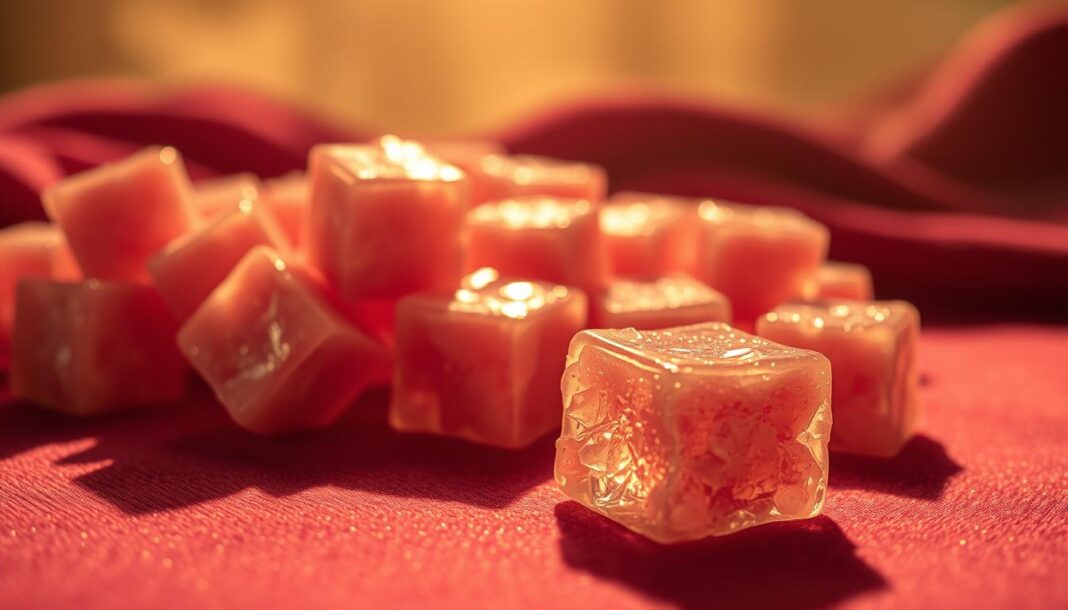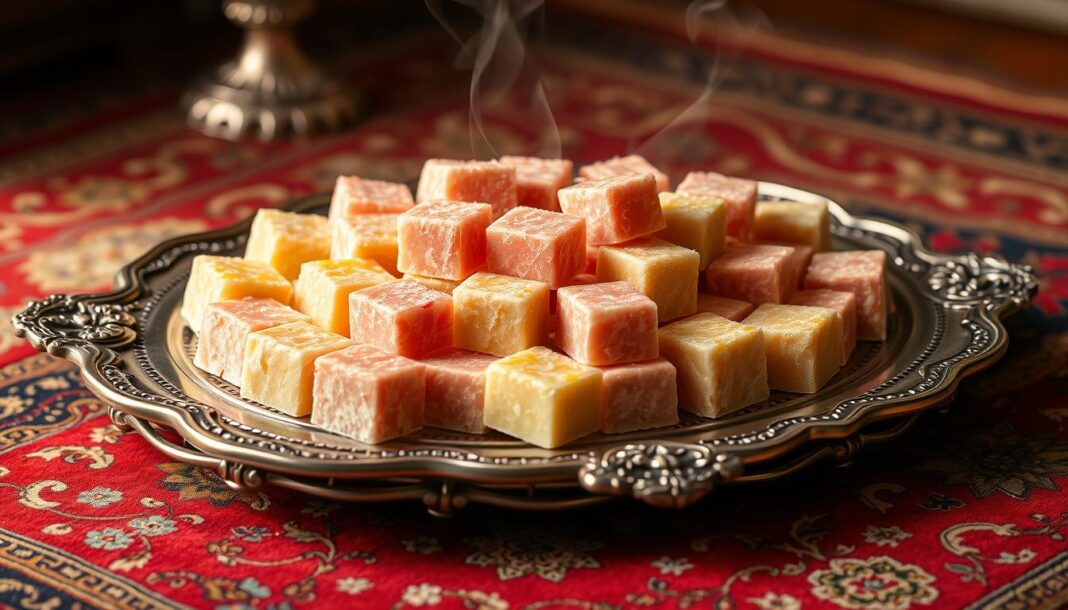In C.S. Lewis’s The Chronicles of Narnia, one of the most pivotal scenes revolves around Edmund Pevensie’s temptation by the White Witch with a magical version of Turkish Delight. This enchanted food, laden with sugar and spellbound charm, sets off a chain of events that shapes the narrative’s course. We will explore the symbolism behind Edmund’s consumption of this sweet treat, examining its representation of temptation, betrayal, and the human capacity for moral failure.
The act of consuming the Turkish Delight is more than a simple indulgence; it signifies Edmund’s deeper desires and vulnerabilities. As we analyze this iconic scene, we will uncover the layers of meaning behind Lewis’s choice of Turkish Delight as the tempting food, considering both its historical context and literary significance.
Key Takeaways
- The consumption of Turkish Delight by Edmund Pevensie is a symbolic act representing temptation and betrayal.
- C.S. Lewis’s choice of Turkish Delight holds historical and literary significance.
- The enchanted food serves as a catalyst for Edmund’s character development throughout The Chronicles of Narnia.
- The scene is an allegory that resonates with readers across generations.
- The symbolism of Turkish Delight is closely tied to themes of moral failure and redemption.
The Temptation Scene in Narnia
The snowy forest of Narnia serves as the backdrop for Edmund’s fateful encounter with the White Witch, a moment that would change the course of the story. This pivotal scene is where C.S. Lewis masterfully weaves together themes of temptation, manipulation, and the corrupting influence of power.
Edmund’s Encounter with the White Witch
Edmund’s vulnerability is expertly exploited by the White Witch as she employs her cunning and magical food to manipulate him. The Turkish Delight she offers is not just a sweet treat but a tool of enchantment that clouds Edmund’s judgment, making him susceptible to her suggestions. This encounter highlights the Witch’s manipulative nature and Edmund’s naivety.
As we analyze this scene, it becomes clear that the White Witch’s use of sugar-laden Turkish Delight is strategic. Having been deprived of sweets due to wartime rationing in England, Edmund is particularly vulnerable to the allure of such a treat. The Witch’s offer is not merely a gesture of kindness but a calculated move to gain Edmund’s trust and extract information from him.
The Magical Properties of the White Witch’s Turkish Delight
The Turkish Delight offered by the White Witch is imbued with magic, making it far more than an ordinary confectionery. Its addictive quality creates an insatiable craving in Edmund, symbolizing how temptation can lead to dependency. The narrative significance of Edmund feeling physically sick after consuming the enchanted food represents the natural consequences of giving in to temptation.
| Aspects of the Turkish Delight | Significance |
|---|---|
| Addictive Quality | Creates insatiable craving, symbolizing dependency |
| Magical Properties | Clouds judgment, making Edmund susceptible to manipulation |
| Physical Reaction | Represents the consequences of giving in to temptation |

By examining the magical properties of the White Witch’s Turkish Delight and its effects on Edmund, we gain insight into C.S. Lewis’s exploration of temptation and its consequences. The use of sugar and food as tools for manipulation underscores the narrative’s deeper themes.
The Symbolism of Edmund Eating Turkish Delight
Edmund’s encounter with the White Witch and her enchanted Turkish Delight is more than just a tempting treat; it’s a rich allegory that underpins the narrative of ‘The Lion, the Witch and the Wardrobe.’ This event is pivotal in understanding Edmund’s character development and the themes of temptation, sin, and betrayal that permeate the story.

Temptation and Sin Allegory
The consumption of Turkish Delight by Edmund serves as a powerful allegory for temptation and sin in Christian theology, echoing C.S. Lewis’s intent to parallel biblical teachings in his narrative. The enchanted nature of the delight signifies the captivating and corrupting influence of sin, making it difficult for Edmund to resist its allure.
The Judas Parallel: Betrayal for Sweetness
A striking parallel can be drawn between Edmund’s betrayal of Aslan for Turkish Delight and Judas Iscariot’s betrayal of Jesus for thirty pieces of silver. Both characters succumb to the temptation of immediate gratification, trading loyalty and moral integrity for temporary pleasure. This parallel underscores the theme of betrayal and the corrupting influence of sugar and temptation.
| Character | Betrayal | Reward |
|---|---|---|
| Judas Iscariot | Betrayed Jesus | Thirty pieces of silver |
| Edmund Pevensie | Betrayed Aslan | Turkish Delight |
Addiction and Control as Literary Devices
C.S. Lewis skillfully employs the addictive properties of the enchanted Turkish Delight as a literary device to illustrate the progressive nature of moral compromise. Edmund’s initial acceptance of the delight leads to an insatiable craving, symbolizing how sin can create patterns of dependency, clouding judgment and leading to increasingly harmful choices. This narrative device highlights the way in which temptation can gradually erode moral resolve.
In conclusion, the symbolism of Edmund eating Turkish Delight is multifaceted, encompassing themes of temptation, sin, betrayal, and the corrupting influence of sugar and desire. Through this narrative element, C.S. Lewis masterfully conveys the complexities of moral compromise and the enduring allure of forbidden pleasure.
Turkish Delight: Historical and Cultural Context
To understand why Turkish Delight was the perfect temptation for Edmund, we need to explore its origins and cultural context. Turkish Delight, also known as Lokum, has a history that dates back to the 18th century in Ottoman Turkey.
Origin and History
The sweet, as we know it today, was invented by Bekir Effendi, a confectioner who moved from Kastamonu to Istanbul and opened his shop in 1776. The name “Lokum” is derived from the Arabic words “luqma(t)” meaning morsel, and its plural form “luqūm” meaning mouthful. Turkish Delight is made from a gel created by heating sugar and starch, giving it a unique texture between gumdrops and Jell-O.
The traditional preparation of Turkish Delight involves a labor-intensive process that requires precise heating of sugar and careful setting, making it a special treat rather than an everyday food. This process contributes to its prestigious status as a food item, particularly in the context of Middle Eastern cuisine.

| Aspect | Description | Significance |
|---|---|---|
| Origin | Invented by Bekir Effendi in 1776 in Istanbul | Marks the beginning of Turkish Delight as we know it |
| Ingredients | Sugar, starch, and flavorings | Creates the distinctive texture and taste |
| Cultural Significance | Prestigious food item in Middle Eastern cuisine | Represents luxury and rarity, especially during wartime rationing |
Why C.S. Lewis Chose This Particular Sweet
C.S. Lewis’s choice of Turkish Delight as the temptation for Edmund can be attributed to its exotic and luxurious nature, particularly in the context of 1940s Britain. During World War II, sweets were rationed, making Turkish Delight a rare and coveted treat. Its foreign origin and the elaborate process of making it added to its allure, making it the perfect temptation for Edmund.
The cultural significance of Turkish Delight as a symbol of luxury and its association with the exotic and unknown would have been particularly appealing to Lewis’s narrative. It represented a treat that was both desirable and forbidden, fitting perfectly into the allegory of temptation and sin.
The Narrative Impact of Edmund’s Choice
Edmund’s decision to accept the White Witch’s Turkish Delight is a pivotal moment in The Chronicles of Narnia, setting the stage for his character development. This event not only drives the plot forward but also serves as a crucial element in understanding Edmund’s transformation throughout the narrative.
Character Development Through Temptation
C.S. Lewis masterfully uses Edmund’s temptation as a way to illustrate universal human weaknesses, making his character relatable despite his betrayal of his siblings. By succumbing to the magic of the White Witch’s delight, Edmund exemplifies the human tendency to prioritize immediate gratification over long-term consequences. This initial surrender to the sugar-laden treat creates the necessary narrative tension that drives much of the plot forward in the story.
The Redemption Arc Following Betrayal
The aftermath of Edmund’s betrayal, facilitated by the White Witch’s Turkish Delight, is a testament to the possibility of redemption in The Chronicles of Narnia. As Edmund navigates the consequences of his actions, he undergoes significant personal growth, ultimately leading to a path of redemption. This narrative arc underscores one of the core themes of the series: that moral failure is not final, and redemption is always possible for those who recognize their mistakes and learn from them, often through hardship and reflection.
Conclusion
The White Witch’s use of magical Turkish Delight to tempt Edmund represents one of literature’s most enduring symbols of temptation and betrayal. In The Chronicles of Narnia, C.S. Lewis deliberately chose this exotic sugar-based confection to embody forbidden pleasure, crafting a metaphor that resonates across generations. The enchanting yet treacherous nature of the Turkish Delight serves as the perfect literary device to illustrate how temptation often comes in attractive, sweet packages but carries hidden consequences.
Edmund’s fateful choice has become an iconic moment in children’s literature, demonstrating how seemingly small decisions can have profound narrative and moral implications. The enduring appeal of this scene lies in its universal themes of temptation, moral weakness, and the struggle between desire and integrity. By examining Edmund’s journey, we gain insight into the powerful symbolism of food in literature, particularly how it can represent broader human experiences and moral dilemmas.
In conclusion, the symbolism of Edmund eating Turkish Delight is a masterstroke of literary craftsmanship, weaving together themes of temptation, betrayal, and redemption in a way that continues to captivate readers. This iconic scene remains a testament to C.S. Lewis’s skill in using the magic of food to explore complex moral and psychological themes.


